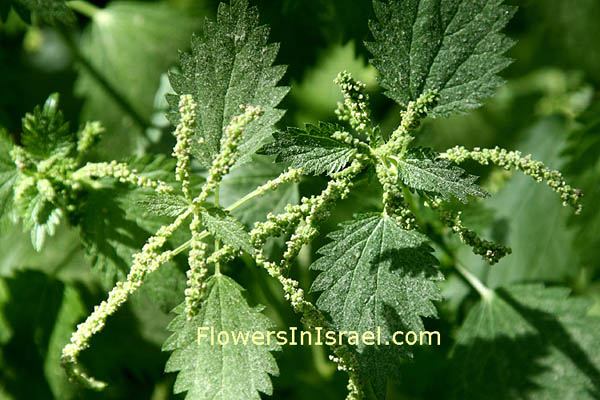Membranous Nettle,
Hebrew: סרפד קרומי, Arabic: قريص غشائي
| Scientific name: | Urtica membranacea Poir. | |
| Synonym name: | Urtica caudata Vahl, Urtica dubia Forssk. | |
| Common name: | Membranous Nettle | |
| Hebrew name: | סרפד קרומי | |
| Arabic name: | قريص غشائي | |
| Plant Family: | Urticaceae, סרפדיים |

|
| Life form: | Annual | |
| Spinescence: | Emergences | |
| Stems: | 15-80 cm high | |
| Leaves: | Opposite | |
| Inflorescence: | Axillary, spike-like, with clustered ultimate branches | |
| Flowers: | Green, racemes unisexual, the lower female shorter than the petiole, the upper male, longer than the petiole; flowers inserted unilaterally on a inflated axis | |
| Fruits / pods: | Achenes, broad ovoid, 1-1.2 x 0.6-0.7 mm; slight lustrous, whitish-yellow | |
| Flowering Period: | January, February, March, April, May | |
| Habitat: | Nutrient-rich soils, ruderal | |
| Distribution: | Mediterranean Woodlands and Shrublands | |
| Chorotype: | Mediterranean | |
| Summer shedding: | Ephemeral |

Derivation of the botanical name: Urtica, uro, I burn, alluding to the nettle's sting; stinging nettle. Their capability to sting makes them useful for metaphors. membranacea, membrana, skin, membrane, parchment; skinlike, membranous. caudata,cauda, tail; having a tail, usually referring to the shape of the inflorescence. dubia, doubtfull, in the sense of not following the genus pattern. The Hebrew name"סרפד, serpad, maybe from סרף = שרף, "Seraf" שרף (resin) and it also indicates the burning characteristic of the plant.
In the Bible three different Hebrew names are quoted: Sirpad (סרפד)- in Isaiah 55:13; Seravim (סרבים)- in Ezekiel 2:6; Harul (הרול)-Zephaniah 2:9. They are synonyms, the roots s-r-f and h-a-r both meaning 'scorching' or 'burning'. Bible resources:
|